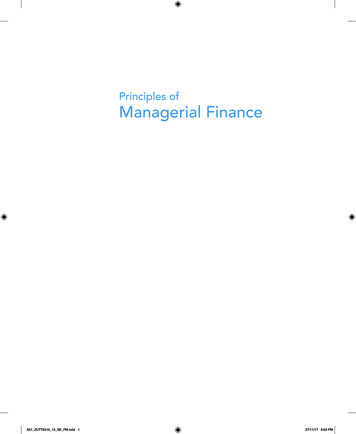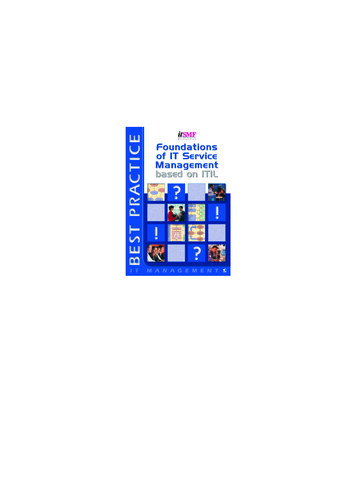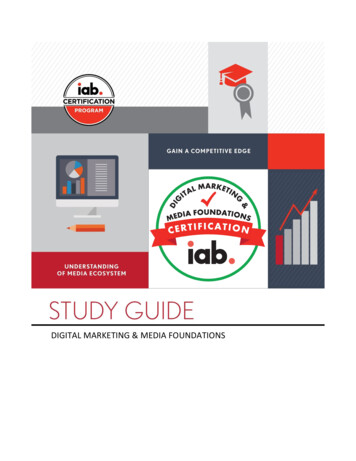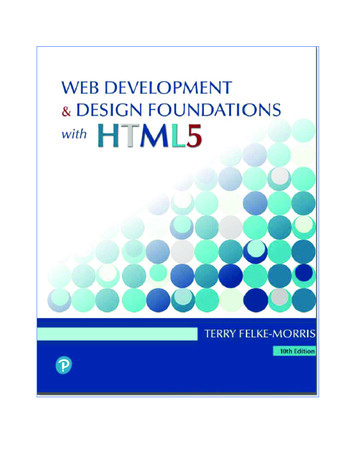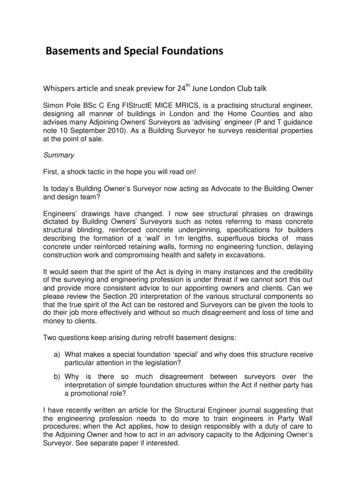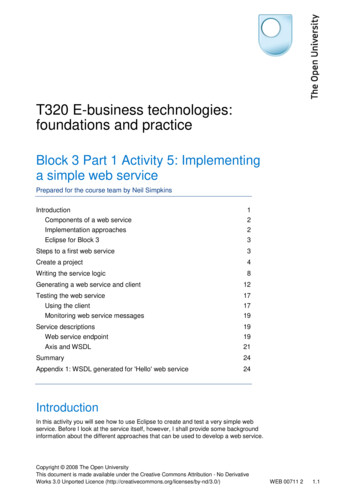
Transcription
Foundations of FinanceThe Logic and Practice of Financial ManagementTenth EditionA01 KEOW7264 10 SE FM.indd 111/30/18 7:26 PM
A01 KEOW7264 10 SE FM.indd 211/30/18 7:26 PM
Foundations of FinanceThe Logic and Practice of Financial ManagementTenth EditionArthur J. KeownVirginia Polytechnic Institute and State UniversityR. B. Pamplin Professor of FinanceJohn D. MartinBaylor UniversityProfessor of FinanceCarr P. Collins Chair in FinanceJ. William PettyBaylor UniversityRetired Professor of FinanceA01 KEOW7264 10 SE FM.indd 311/30/18 7:26 PM
Vice President, Business, Economics, and UK Courseware:Donna BattistaDirector of Portfolio Management: Adrienne D’AmbrosioEditorial Assistant: Catherine CinqueVice President, Product Marketing: Roxanne McCarleyProduct Marketer: Kaylee CarlsonProduct Marketing Assistant: Marianela SilvestriManager of Field Marketing, Business Publishing:Adam GoldsteinExecutive Field Marketing Manager: Thomas HaywardVice President, Production and Digital Studio, Artsand Business: Etain O’DeaDirector of Production and Digital Studio, Arts and Business:Ashley SantoraManaging Producer, Business: Alison KalilContent Producer: Meredith GertzOperations Specialist: Carol MelvilleDesign Lead: Kathryn FootManager, Learning Tools: Brian SuretteSenior Learning Tools Strategist: Emily BibergerManaging Producer, Digital Studio and GLP: James BatemanManaging Producer, Digital Studio: Diane LombardoDigital Studio Producer: Melissa HonigDigital Studio Producer: Alana ColesDigital Content Team Lead: Noel LotzDigital Content Project Lead: Miguel LeonarteProject Manager: Kim Fletcher, Integra Software Services Inc.Interior Design: Integra Software Services Inc.Cover Design: Integra Software Services Inc.Cover Art: Nikolamirejovska/ShutterstockPrinter/Binder: LSC Communications, Inc./KendallvilleCover Printer: Phoenix Color/HagerstownMicrosoft and/or its respective suppliers make no representations about the suitability of the information contained in the documents andrelated graphics published as part of the services for any purpose. All such documents and related graphics are provided “as is” withoutwarranty of any kind. Microsoft and/or its respective suppliers hereby disclaim all warranties and conditions with regard to this information, including all warranties and conditions of merchantability, whether express, implied or statutory, fitness for a particular purpose, titleand non-infringement. In no event shall Microsoft and/or its respective suppliers be liable for any special, indirect or consequential damages or any damages whatsoever resulting from loss of use, data or profits, whether in an action of contract, negligence or other tortiousaction, arising out of or in connection with the use or performance of information available from the services.The documents and related graphics contained herein could include technical inaccuracies or typographical errors. Changes are periodicallyadded to the information herein. Microsoft and/or its respective suppliers may make improvements and/or changes in the product(s) and/or the program(s) described herein at any time. Partial screen shots may be viewed in full within the software version specified.Microsoft and Windows are registered trademarks of the Microsoft Corporation in the U.S.A. and other countries. This book is not sponsored or endorsed by or affiliated with the Microsoft Corporation.Copyright 2020, 2017, 2014 by Pearson Education, Inc. or its affiliates. All Rights Reserved. Manufactured in the United States of America.This publication is protected by copyright, and permission should be obtained from the publisher prior to any prohibited reproduction,storage in a retrieval system, or transmission in any form or by any means, electronic, mechanical, photocopying, recording, or otherwise.For information regarding permissions, request forms, and the appropriate contacts within the Pearson Education Global Rights and Permissions department, please visit www.pearsoned.com/permissions/.Acknowledgments of third-party content appear on the appropriate page within the text. Photo credits: p. 3: Iain Masterton/Alamy StockPhoto; p. 23: Paul Sakuma/AP images; p. 55: QualityHD/Shutterstock; p. 101: Sundry Photography/Shutterstock; p. 143: Jorge Salcedo/Shutterstock; p. 187: ZUMA Press, Inc./Alamy Stock Photo; p. 227: Age fotostock/Alamy Stock Photo; p. 259: Dpa picture alliance/AlamyStock Photo; p. 266: BernardAllum/DigitalVision Vectors; p. 285: PSL Images/Alamy Stock Photo; p. 319: Elvin Cheng/Alamy Stock Photo; p. 359:Larry W Smith/Newscom; p. 399: Stuwdamdorp/Alamy Stock Photo; p. 439: Various-Everythings/Shutterstock; p. 461: DPD ImageStock/Alamy Stock Photo; p. 481: Paul Sakuma/AP images; p. 511: Hemis/Alamy Stock Photo; p. W-2: Lourens Smak/Alamy Stock PhotoPEARSON, ALWAYS LEARNING, and MYLAB are exclusive trademarks owned by Pearson Education, Inc. or its affiliates in the U.S. and/or other countries.Unless otherwise indicated herein, any third-party trademarks, logos, or icons that may appear in this work are the property of theirrespective owners, and any references to third-party trademarks, logos, icons, or other trade dress are for demonstrative or descriptive purposes only. Such references are not intended to imply any sponsorship, endorsement, authorization, or promotion of Pearson’s products by the owners of such marks, or any relationship between the owner and Pearson Education, Inc., or its affiliates, authors, licensees, or distributors.Library of Congress Cataloging-in-Publication DataNames: Keown, Arthur J. Martin, John D. Petty, J. WilliamTitle: Foundations of Finance: The Logic and Practice of FinancialManagement/Arthur J Keown, John D Martin, J. William Petty.Description: Tenth Edition. New York, NY: Pearson, [2020] Revisededition of the authors’ Foundations of Finance, [2017] Includes indexes.Identifiers: LCCN 2018042981 ISBN 9780134897264 ISBN 0134897269Subjects: LCSH: Corporations—Finance.Classification: LCC HG4026.F67 2019 DDC 658.15–dc23LC record available at https://lccn.loc.gov/2018042981119ISBN 10: 0-13-489726-9ISBN 13: 978-0-13-489726-4A01 KEOW7264 10 SE FM.indd 411/30/18 7:26 PM
To my parents, from whom I learned the most.Arthur J. KeownTo the Martin women—wife Sally and daughter-in-law Mel, theMartin men—sons Dave and Jess, and the Martin boys—grandsonsLuke and Burke.John D. MartinTo Carter and Greg, who are great husbands to our lovely daughters,Krista and Kate, and the fathers of our five wonderfulgrandchildren—Ashley, Cameron, Erin, John, and Mackenzie.We feel their constant love and friendship.J. William PettyA01 KEOW7264 10 SE FM.indd 511/30/18 7:26 PM
About the AuthorsArthur J. Keown is the Department Head and R. B. Pamplin Professor ofFinance at Virginia Polytechnic Institute and State University. He received hisbachelor’s degree from Ohio Wesleyan University, his M.B.A. from the Universityof Michigan, and his doctorate from Indiana University. An award-winning teacher,he is a member of the Academy of Teaching Excellence; has received five Certificates of Teaching Excellence at Virginia Tech, the W. E. Wine Award for TeachingExcellence, and the Alumni Teaching Excellence Award; and in 1999 received theOutstanding Faculty Award from the State of Virginia. Professor Keown is widelypublished in academic journals. His work has appeared in the Journal of Finance,Journal of Financial Economics, Journal of Financial and Quantitative Analysis, Journalof Financial Research, Journal of Banking and Finance, Financial Management, Journal ofPortfolio Management, and many others. In addition to Foundations of Finance, twoothers of his books are widely used in college finance classes all over the country—Basic Financial Management and Personal Finance: Turning Money into Wealth. Professor Keown is a Fellow of the Decision Sciences Institute, was a member of the Boardof Directors of the Financial Management Association, and is the head of the financedepartment at Virginia Tech. In addition, he served as the co-editor of the Journal ofFinancial Research for 6 ½ years and as the co-editor of the Financial ManagementAssociation’s Survey and Synthesis series for 6 years. He lives with his wife in Blacksburg, Virginia, where he collects original art from Mad Magazine.John D. Martin retired from Baylor University where he was the Carr P.Collins Chair of Finance after having retired earlier from the University of Texasat Austin where he held the Margaret and Eugene McDermott Professorship inFinance. He now lives on a small ranch near Crawford, TX where he and his wiferaise Braunvieh-Angus cross cattle, bale a little hay and enjoy life. In his prior lifeas professor of finance, John taught for almost a half century earning a number ofteaching awards, published over 50 articles in the leading finance journals, andcoauthored ten books including Financial Management: Principles and Practice(13th edition, Pearson), Foundations of Finance (10th edition Pearson), Valuation: TheArt and Science of Corporate Investment Decisions (3rd edition, Pearson) and ValueBased Management with Social Responsibility (2nd edition, Oxford University Press).When not involved in farming and ranching, John feeds his learning habit byremaining an active researcher and writer. His current research interests focus onAmerica’s energy dependence problem as it relates to the economics of unconventional energy sources, educating entrepreneurs concerning the true cost of venturefunding, and investigating the economic factors underlying differences in the costsof capital among emerging economies. Finally, John’s abiding passion is to createa series of digital books that will meet the evolving needs of the next generation ofcollege students.viA01 KEOW7264 10 SE FM.indd 611/30/18 7:26 PM
J. William Petty, PhD, Baylor University, was Professor of Finance andW. W. Caruth Chair of Entrepreneurship from 1990 until 2017. Dr. Petty taughtentrepreneurial finance at both the undergraduate and graduate levels. He was designated a University Master Teacher. In 2008, the Acton Foundation for Entrepreneurship Excellence selected him as the National Entrepreneurship Teacher ofthe Year. His research interests included the financing of entrepreneurial firms andshareholder value-based management. He served as the co-editor for the Journalof Financial Research and the editor of the Journal of Entrepreneurial Finance. He haspublished articles in various academic and professional journals, including Journalof Financial and Quantitative Analysis, Financial Management, Journal of PortfolioManagement, Journal of Applied Corporate Finance, and Accounting Review. Dr. Pettyis co-author of a leading textbook in small business and entrepreneurship, SmallBusiness Management: Launching and Growing Entrepreneurial Ventures. He alsoco-authored Value-Based Management: Corporate America’s Response to the ShareholderRevolution (2010). He served on the Board of Directors of a publicly traded oil andgas firm. Finally, he serves on the Board of the Baylor Angel Network, a network ofprivate investors who provide capital to start-ups and early-stage companies.viiA01 KEOW7264 10 SE FM.indd 711/30/18 7:26 PM
Brief ContentsPrefacexviiPART 1 The Scope and Environmentof Financial Management 21234PART 256789PART 31011PART 41213PART 5An Introduction to the Foundations of Financial ManagementThe Financial Markets and Interest Rates 22Understanding Financial Statements and Cash Flows 54Evaluating a Firm’s Financial Performance 100The Valuation of Financial Assets142The Time Value of Money 142The Meaning and Measurement of Risk and ReturnThe Valuation and Characteristics of Bonds 226The Valuation and Characteristics of Stock 258The Cost of Capital 284Investment in Long-Term Assets186318Capital-Budgeting Techniques and Practice 318Cash Flows and Other Topics in Capital BudgetingCapital Structure and Dividend PolicyDetermining the Financing Mix 398Dividend Policy and Internal Financing2358398438 orking-Capital Management and InternationalWBusiness Finance 46014 Short-Term Financial Planning 46015 Working-Capital Management 48016 International Business Finance 510Web 17 Cash, Receivables, and Inventory ManagementAvailable online at www.pearson.com/mylab/financeWeb Appendix A Using a CalculatorAvailable online at www.pearson.com/mylab/financeGlossary 532Indexes 541viiiA01 KEOW7264 10 SE FM.indd 811/30/18 7:26 PM
ContentsPrefacePART 11xviiT he Scope and Environmentof Financial Management 2An Introduction to the Foundations of FinancialManagement 2The Goal of the Firm3Five Principles That Form the Foundations of FinancePrinciple 1: Cash Flow Is What Matters 4Principle 2: Money Has a Time Value 5Principle 3: Risk Requires a Reward 5Principle 4: Market Prices Are Generally Right 6Principle 5: Conflicts of Interest Cause Agency ProblemsThe Essential Elements of Ethics and Trust 9The Role of Finance in BusinessWhy Study Finance? 11The Role of the Financial Manager481011The Legal Forms of Business Organization12Sole Proprietorships 12Partnerships 13Corporations 13Organizational Form and Taxes: The Double Taxation on Dividendsand Pass-Through Entities 14S-Corporations and Limited Liability Companies (LLCs) 14Which Organizational Form Should Be Chosen? 15Finance and the Multinational Firm: The New RoleDeveloping Skills for Your CareerChapter Summaries2151617 Review Questions 20 Mini Case 21The Financial Markets and Interest Rates22Financing of Business: The Movement of Funds Throughthe Economy 24Public Offerings Versus Private Placements 25Primary Markets Versus Secondary Markets 26The Money Market Versus the Capital Market 27Spot Markets Versus Futures Markets 27Stock Exchanges: Organized Security Exchanges Versus Over-the-CounterMarkets, a Blurring Difference 27Selling Securities to the Public29Functions 29Distribution Methods 30Private Debt Placements 31Flotation Costs 33Regulation Aimed at Making the Goal of the Firm Work:The Sarbanes-Oxley Act 33Rates of Return in the Financial Markets34Rates of Return over Long Periods 34Interest Rate Levels in Recent Periods 35ixA01 KEOW7264 10 SE FM.indd 911/30/18 7:26 PM
xContentsInterest Rate Determinants in a Nutshell38Estimating Specific Interest Rates Using Risk Premiums 38Real Risk-Free Interest Rate and the Risk-Free Interest Rate 39Real and Nominal Rates of Interest 39Inflation and Real Rates of Return: The Financial Analyst’s ApproachThe Term Structure of Interest Rates 43Shifts in the Term Structures of Interest Rates 43What Explains the Shape of the Term Structure? 4541Chapter Summaries 47 Review Questions 50 Study Problems 50 Mini Case 533Understanding Financial Statements and CashFlows 54The Income Statement56The Makeup of an Income Statement 56Walmart’s Income Statement 57Restating Walmart’s Income Statement 59The Balance Sheet61Types of Assets 62Types of Financing 63Walmart’s Balance SheetWorking Capital 66Measuring Cash Flows6569Profits Versus Cash Flows 69The Beginning Point: Changes in the Balance Sheet and Cash FlowsStatement of Cash Flows 71Concluding Suggestions for Computing Cash Flows 78What Have We Learned about Walmart? 7970The Limitations of Financial Statements and Accounting Malpractice 80Chapter Summaries 80 Review Questions 83 Study Problems 84 Mini Case 91Appendix 3A: Free Cash FlowsComputing Free Cash Flows94Computing Financing Cash FlowsStudy Problems4949697Evaluating a Firm’s Financial PerformanceThe Purpose of Financial Analysis100100Measuring Key Financial Relationships103Question 1: How Liquid Is the Firm—Can It Pay Its Bills? 105Question 2: Are the Firm’s Managers Generating Adequate Operating Profits onthe Company’s Assets? 110Managing Operations 112Managing Assets 112Question 3: How Is the Firm Financing Its Assets? 117Question 4: Are the Firm’s Managers Providing a Good Return on the CapitalProvided by the Company’s Shareholders? 120Question 5: Are the Firm’s Managers Creating Shareholder Value? 124The Limitations of Financial Ratio Analysis129Chapter Summaries 130 Review Questions 133 Study Problems 133 Mini Case 140A01 KEOW7264 10 SE FM.indd 1011/30/18 7:26 PM
ContentsPART 25The Valuation of Financial AssetsThe Time Value of Moneyxi142142Compound Interest, Future Value, and Present Value144Using Timelines to Visualize Cash Flows 144Techniques for Moving Money Through Time 147Two Additional Types of Time Value of Money Problems 152Applying Compounding to Things Other Than Money 153Present Value 154Annuities158Compound Annuities 158The Present Value of an AnnuityAnnuities Due 162Amortized Loans 163160Making Interest Rates Comparable165Calculating the Interest Rate and Converting It to an EAR 167Finding Present and Future Values With Nonannual Periods 168Amortized Loans With Monthly Compounding 171The Present Value of an Uneven Stream and PerpetuitiesPerpetuitiesChapter Summaries Mini Case 1856172173174 Review Questions 177 Study Problems177The Meaning and Measurement of Riskand Return 186Expected Return Defined and MeasuredRisk Defined and Measured188191Rates of Return: The Investor’s ExperienceRisk and Diversification198199Diversifying Away the Risk 200Measuring Market Risk 201Measuring a Portfolio’s Beta 208Risk and Diversification Demonstrated209The Investor’s Required Rate of Return212The Required Rate of Return Concept 212Measuring the Required Rate of Return 212Chapter Summaries Mini Case 2247215 Review Questions 219 Study Problems219The Valuation and Characteristics of BondsTypes of Bonds226227Debentures 227Subordinated Debentures 228Mortgage Bonds 228Eurobonds 228Convertible Bonds 228Terminology and Characteristics of BondsClaims on Assets and IncomePar Value 230Coupon Interest Rate 230Maturity 230Call Provision 230A01 KEOW7264 10 SE FM.indd 1122923011/30/18 7:26 PM
xiiContentsIndenture 231Bond Ratings 231Defining Value232What Determines Value?234Valuation: The Basic Process235Valuing Bonds 236Bond Yields242Yield to Maturity 242Current Yield 244Bond Valuation: Three Important Relationships245Chapter Summaries 250 Review Questions 253 Study Problems Mini Case 2578254The Valuation and Characteristics of StockPreferred Stock260The Characteristics of Preferred StockValuing Preferred StockCommon Stock258260261265The Characteristics of Common StockValuing Common Stock265267The Expected Rate of Return of Stockholders272The Expected Rate of Return of Preferred Stockholders 273The Expected Rate of Return of Common Stockholders 274Chapter Summaries 277 Review Questions 280 Study Problems Mini Case 2839The Cost of Capital280284The Cost of Capital: Key Definitions and Concepts285Capital Structure 285Opportunity Costs, Required Rates of Return, and the Cost of CapitalThe Firm’s Financial Policy and the Cost of Capital 287286Determining the Costs of the Individual Sources of CapitalThe Cost of Debt 288The Cost of Preferred Stock 291The Cost of Common Equity 292The Dividend Growth Model and the Implied Cost of EquityIssues in Implementing the Dividend Growth Model 294The Capital Asset Pricing Model 295Issues in Implementing the CAPM 296The Weighted Average Cost of Capital293298Capital Structure Weights 298Calculating the Weighted Average Cost of CapitalCalculating Divisional Costs of Capital299301Estimating Divisional Costs of Capital 301Using Pure Play Firms to Estimate Divisional WACCs 301Using a Firm’s Cost of Capital to Evaluate New Capital InvestmentsChapter Summaries 307 Review Questions 310 Study Problems Mini Cases 316A01 KEOW7264 10 SE FM.indd 1228830531011/30/18 7:26 PM
ContentsPART 310Investment in Long-Term Assets318Capital-Budgeting Techniques and PracticeFinding Profitable Projectsxiii318319Capital-Budgeting Decision Criteria320The Payback Period 320The Net Present Value 324Using Spreadsheets to Calculate the Net Present Value 327The Profitability Index (Benefit–Cost Ratio) 327The Internal Rate of Return 330Computing the IRR for Uneven Cash Flows with a Financial Calculator 332Viewing the NPV–IRR Relationship: The Net Present Value Profile 333Complications with the IRR : Multiple Rates of Return 334The Modified Internal Rate of Return (MIRR)2 335Using Spreadsheets to Calculate the MIRR 338A Last Word on the MIRR 339Capital Rationing339The Rationale for Capital Rationing 340Capital Rationing and Project Selection 341Ranking Mutually Exclusive Projects341The Size-Disparity Problem 342The Unequal-Lives Problem 343Chapter Summaries Mini Case 35611346 Review Questions 349 Study Problems350Cash Flows and Other Topics in CapitalBudgeting 358Guidelines for Capital Budgeting359Use Free Cash Flows Rather Than Accounting Profits 359Think Incrementally 359Beware of Cash Flows Diverted from Existing Products 360Look for Incidental or Synergistic Effects 360Work in Working-Capital Requirements 360Consider Incremental Expenses 361Remember That Sunk Costs Are Not Incremental Cash Flows 361Account for Opportunity Costs 361Decide If Overhead Costs Are Truly Incremental Cash Flows 361Ignore Interest Payments and Financing Flows 362Calculating a Project’s Free Cash Flows362What Goes into the Initial Outlay 362What Goes into the Annual Free Cash Flows over the Project’s LifeWhat Goes into the Terminal Cash Flow 365Calculating the Free Cash Flows 366A Comprehensive Example: Calculating Free Cash Flows 370Options in Capital Budgeting363374The Option to Delay a Project 374The Option to Expand a Project 375The Option to Abandon a Project 376Options in Capital Budgeting: The Bottom LineRisk and the Investment Decision376376What Measure of Risk Is Relevant in Capital Budgeting? 377Measuring Risk for Capital-Budgeting Purposes with a Doseof Reality—Is Systematic Risk All There Is? 378Incorporating Risk into Capital Budgeting 379Risk-Adjusted Discount Rates 379Measuring a Project’s Systematic Risk 382A01 KEOW7264 10 SE FM.indd 1311/30/18 7:26 PM
xivContentsUsing Accounting Data to Estimate a Project’s Beta 382The Pure Play Method for Estimating Beta 383Examining a Project’s Risk Through Simulation 383Conducting a Sensitivity Analysis Through Simulation 385Chapter Summaries 386 Review Questions 388 Study Problems Mini Case 394388Appendix 11A: The Modified Accelerated CostRecovery System 396What Does All This Mean?Study ProblemsPART 412397397Capital Structure and Dividend Policy398Determining the Financing Mix 398Understanding the Difference Between Businessand Financial Risk 400Business Risk 401Operating Risk 401Break-Even Analysis401Essential Elements of the Break-Even ModelFinding the Break-Even Point 404The Break-Even Point in Sales Dollars 405Sources of Operating Leverage402406Financial Leverage 408Combining Operating and Financial LeverageCapital Structure Theory410412A Quick Look at Capital Structure Theory 414The Importance of Capital Structure 414Independence Position 414The Moderate Position 416Firm Value and Agency Costs 418Agency Costs, Free Cash Flow, and Capital StructureManagerial Implications 420420The Basic Tools of Capital Structure Management 421EBIT-EPS Analysis 421Comparative Leverage Ratios 424Industry Norms 425Net Debt and Balance-Sheet Leverage Ratios 425A Glance at Actual Capital Structure Management 425Chapter Summaries 428 Review Questions 431 Study Problems Mini Cases 43413Dividend Policy and Internal Financing432438How do Firms Distribute Firm Profits to their Stockholders?Does Dividend Policy Matter to Stockholders?Three Basic Views 440Making Sense of Dividend Policy TheoryWhat Are We to Conclude? 445The Dividend Decision in Practice439440442446Legal Restrictions 446Liquidity Constraints 446Earnings Predictability 446A01 KEOW7264 10 SE FM.indd 1411/30/18 7:26 PM
ContentsxvMaintaining Ownership Control 447Alternative Dividend Policies 447Dividend Payment Procedures 447Stock Dividends and Stock SplitsStock Repurchases448449A Share Repurchase as a Dividend Decision 450The Investor’s Choice 451A Financing Decision or an Investment Decision? 452Practical Considerations—The Stock Repurchase ProcedureChapter Summaries Mini Case 459452453 Review Questions 455 Study Problems456PART 5 Working-Capital Management and InternationalBusiness Finance 46014Short-Term Financial PlanningFinancial Forecasting460461The Sales Forecast 461Forecasting Financial Variables 461The Percent of Sales Method of Financial Forecasting 462Analyzing the Effects of Profitability and Dividend Policy on DFNAnalyzing the Effects of Sales Growth on a Firm’s DFN 464463Limitations of the Percent of Sales Forecasting Method 467Constructing and Using a Cash Budget468Budget Functions 468The Cash Budget 469Chapter Summaries15471 Review Questions 473 Study ProblemsWorking-Capital ManagementManaging Current Assets and Liabilities473480481The Risk–Return Trade-Off 482The Advantages of Current versus Long-term Liabilities: Return 482The Disadvantages of Current versus Long-term Liabilities: Risk 482Determining the Appropriate Level of WorkingCapital 483The Hedging Principle 483Permanent and Temporary Assets 484Temporary, Permanent, and Spontaneous Sources of FinancingThe Hedging Principle: A Graphic Illustration 484Using the Cash Conversion Cycle484486Estimating the Cost of Short-Term Credit Using the ApproximateCost-of-Credit Formula 488Evaluating Sources of Short-Term Credit490Unsecured Sources: Accrued Wages and Taxes 490Unsecured Sources: Trade Credit 492Unsecured Sources: Bank Credit 493Finance at Work 495Unsecured Sources: Commercial Paper 496Secured Sources: Accounts-Receivable Loans 498Secured Sources: Inventory Loans 500Chapter SummariesA01 KEOW7264 10 SE FM.indd 15501 Review Questions 504 Study Problems50511/30/18 7:26 PM
xviContents16International Business Finance510The Globalization of Product and Financial Markets511Foreign Exchange Markets and Currency Exchange RatesForeign Exchange Rates 513What a Change in the Exchange Rate Means for BusinessExchange Rates and Arbitrage 516Asked and Bid Rates 516Cross Rates 517Types of Foreign Exchange Transactions 518Exchange Rate Risk 520Interest Rate Parity512513522Purchasing-Power Parity and the Law of One PriceThe International Fisher Effect523524Capital Budgeting for Direct Foreign InvestmentRepatriation of Profits and Taxation of Profits AbroadForeign Investment Risks 525524525Chapter Summaries 526 Review Questions 529 Study Problems Mini Case 530529Web 17 C ash, Receivables, and InventoryManagementAvailable online at www.pearson.com/mylab/financeWeb Appendix A Using a CalculatorAvailable online at www.pearson.com/mylab/financeGlossary 532Indexes 541A01 KEOW7264 10 SE FM.indd 1611/30/18 7:26 PM
PrefaceThe study of finance focuses on making decisions that enhance the value of thefirm. This is done by providing customers with the best products and servicesin a cost-effective way. In a sense we, the authors of Foundations of Finance, sharethe same purpose. We have tried to create a product that provides value to our customers—both students and instructors who use the text. It was this priority thatled us to write Foundations of Finance: The Logic and Practice of Financial Management, which was the first “shortened book” of financial management when it wasoriginally published. This text launched a trend that has since been followed by allthe major competing texts in this market. The text broke new ground not only byreducing the breadth of materials covered but also by employing a more intuitiveapproach to presenting new material. From that first edition, the text has met withsuccess beyond our expectations for nine editions. For that success, we are eternallygrateful to the multitude of finance instructors who have chosen to use the text intheir classrooms.New to the Tenth EditionMany of the changes in the 10th edition stem from comments and suggestions madeby adopters, and we thank them for all they have done to improve this edition. Otherchanges were inspired by the passage of the Tax Cuts and Jobs Act of 2017. This newlaw brought sweeping changes to corporate taxes. Some of the tax changes that thatwill impact corporate finance decisions include a dramatic reduction in the corporatetax rate, the ability to depreciate the full purchase price of capital investments in theyear the investment is put into service, a limitation on the tax deductibility of interestpayments, and a change in the taxation of foreign profits. Needless to say, the impactof these tax changes ripple throughout the book. For example, corporate decisionmaking, with respect to new investments in new projects and how those projects arefinanced, are impacted by the new tax law.In addition to the integration of the new tax law throughout the book, we havemade some chapter-by-chapter updates in response to the continued developmentof financial thought and reviewer comments. By chapter, some of these changesinclude:Chapter 1An Introduction to the Foundations of Financial Management Revised and updated chapter introduction Revised and updated section on the Organizational Form and Taxes to includechanges resulting from the new tax laws and changes to pass-through entitiesChapter 2The Financial Markets and Interest Rates Revised and updated chapter introduction Revised coverage to include recent changes in the financial markets Updated coverage of the term structure of interest rates to address the very lowrates that characterize today’s marketsxviiA01 KEOW7264 10 SE FM.indd 1711/30/18 7:26 PM
xviiiPrefaceChapter 3Understanding Financial Statements and Cash Flows Streamlined bullet point presentations that can be reviewed by the reader toquickly grasp new concepts Updated to illustrate the principles of financial statements, using a company thatwill be of interest to students—Walmart Rather than merely present Walmart’s financial statements in isolation, background material is provided about Walmart that will give context to the company’s financialsChapter 4Evaluating a Firm’s Financial Performance Str
(13th edition, Pearson), Foundations of Finance (10th edition Pearson), Valuation: The Art and Science of Corporate Investment Decisions (3rd edition, Pearson) and Value Based Management with Social Responsibility (2nd edition, Oxford University Press). When not involved


